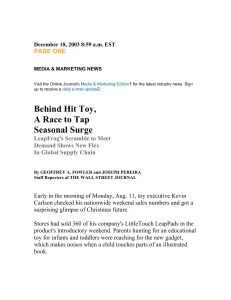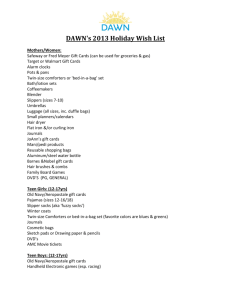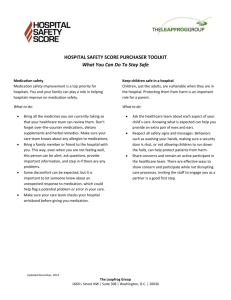Company Overview
advertisement
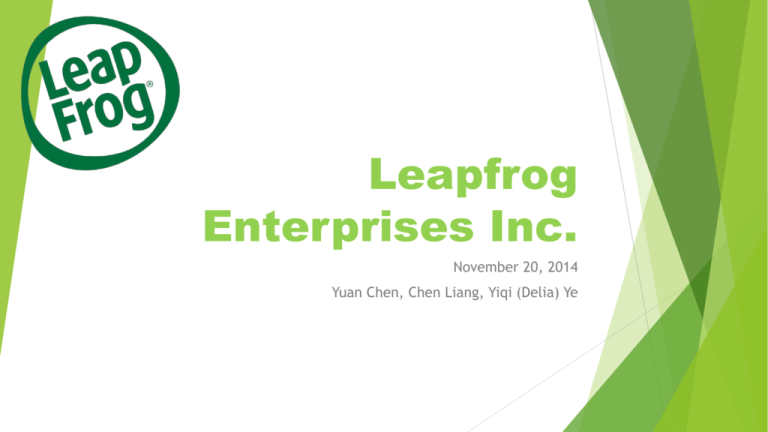
Leapfrog Enterprises Inc. November 20, 2014 Yuan Chen, Chen Liang, Yiqi (Delia) Ye Agenda Current Holdings Company Overview Macroeconomic Review Industry Review Business Strategy & Corporate Governance Financial Analysis Valuation Recommendation Current Position 2,000 shares bought on April 5th, 2013 @ $8.19 Current Price: $5.45 (11/19/2014) Total Loss: -33.49% Portfolio Shares (MV): 5.80% LF 5.80% Source: Yahoo! Finance RCMP Portfolio (https://finance.yahoo.com/portfolio/pf_1) ABBV ABT AEO AL COF JKHY LF NHC PETM SNA UNP WAG ZIXI Relevant Stock Performance Source: Bloomberg Finance: LF & Russell 2000 Index Spread Company Overview Traded on the NYSE with ticker symbol LF Founded in 1995 by Micheal Wood and Robert Lally and headquartered in Emeryville, California USA GICS Sector: Leisure Products Sub-Industry: Toys & Games Focus: Educational entertainment toys 579 full-time employees as of December 31, 2013 Source: LeapFrog 10K 2013, Bloomberg Finance Business Segments & Distribution Channel Global Revenue Breakdown: Other Countries, 19% Three main retailers: Wal-Mart Toys R Us Target United Kingdom, 11% United States, 70% Wal-Mart, 25% Others, 49.00% Toys "R" Us, 15% Target, 11% Source: LeapFrog 10K 2013: Page 67,69 Major Products & Services Products: Multimedia learning platforms LeapPad Family of Learning Tablets (3-9 yrs.) Leapster Family of Handheld Learning Game System (4-9 yrs.) LeapReader Reading System (1-8 yrs.) LeapTV (3-8 yrs.) Learning toys Dozens of Product Lines (0-6 yrs.) Services: LeapFrog Learning Path Over 1,200 downloadable Apps in Online Application Center Source: LeapFrog Website http://www.leapfrog.com/en-us/store/ Major Products & Services LeapPad 2 LeapPad Ultra LeapPad 3 LeapTV Release Date June 2012 June 2013 June 2014 October 2014 Price $ 79.99 $ 129.99 $ 99.99 $ 149.99 Age Range 3-9 years 3-9 years 3-9 years 3-8 years Apps 100+ Games & Videos Over 1,200 Apps Peer-to-peer play × ✓ ✓ ✓ Amazon Rating 4.5/5.0 (860) 3.5/5.0 (754) 4.5/5.0 (143) 4.5/5.0 (58) Source: Amazon, LeapFrog Website http://www.leapfrog.com/en-us/store/ Macroeconomics Overview Consumer confidence Per Capita Disposable income Source: Federal Reserve Bank of St. Louis (http://research.stlouisfed.org/fred2/series/A229RX0) Macroeconomics Overview Toy spending per child worldwide Child population distribution United Kingdom United States France Billions Population (Age<15) 1.40 1.20 1.00 0.80 0.60 0.40 0.20 - Source: Population Reference Bureau (http://www.prb.org/DataFinder/Topic/Bars.aspx?ind=14&loc=246,310,341,355,412,463,241), Statista (http://www.statista.com/statistics/194424/amount-spent-on-toys-per-child-by-country-since-2009/) 2014 Population 2030 Population Projection Porter 5 Forces Analysis ― Toys and Games Industry Barrier to entry: Moderate & Decreasing · High-cost and long-term nature of brand reputation · Declining life-cycle · Targeting niche markets Threat of Substitutes: Moderate & Increasing Competition: High & Steady · Psychographic shifts · Numerous players · Digital games, education and entertainment · Low switching costs Porter 5 Forces · Peer affect · Low profit margin · Short-lived and/or seasonal · Technology · Other leisure activities Bargaining Power of Suppliers: Moderate & Steady Bargaining Power of Buyers: Moderate & Decreasing · Licensing rights on popular brands · Players being retailers · Less substitute products · Low individual profitability and prevalence of available end customers · Forward integration · Government regulation Competitors Analysis Multimedia learning products Vtech Holding Ltd. Fuhu, Inc. Learning toy category Vtech Holdings Ltd. Mattel, Inc.: Fisher-Price brand Hasbro, Inc.: Playskool division General tablet computers and eBook readers: Apple, Amazon and Samsung, and the Sony and Nintendo handheld gaming systems SWOT Analysis Strength • • • • • • Higher quality educational products Age-appropriate and personalized education curricula Award-winning learning solutions Online learning world for children Easy-to-use parent resource center No interest-bearing long-term debt Opportunities • • • • Demographic and psychographic shifts International expansion New platform Downloadable content library Weakness • • • • Price premium All products under single brand Seasonal High fixed costs Threats • • • • • Safety standard Competitors Loss skilled workers Industry declining Highly changeable consumer preferences Source: Q2 2015 LeapFrog Enterprises Inc. Earnings Call, LeapFrog Enterprises Inc. 10-K Weakness and Risks Price Premium High Fixed costs Overly Concentrated Distribution Channel Highly Seasonal and Fluctuating Sales Three biggest retailers accounts for more than 50% of net sales More than 70% of sales is made during holiday season each year Highly Changeable Consumer Preference and Product Trend Sales is highly depend on new product Source: LeapFrog 10K 2013, Page 10-17 Risk Factors – A Special Concern Suspicious Earnings of 2012 and 2013 Changes in Valuation Allowance account for 50% and 75% of Net Income in 2012 and 2013, respectively Net Income after Valuation Allowance Adjustment Taxable Income Net Income Adjusted Net Income 86 84 62 43 34 19 21 20 13 2011 Source: LeapFrog 10K 2013, Page 42, 56-58 2012 2013 Business Strategy Build an operational foundation to support future Invest heavily in new platform and content library development Looking into international market Increase international revenue to 50% of total revenue New Chief International Officer, Antony Hicks Leverage content assets across many platforms 1200+ apps for tablets & 100+ games and videos for LeapTV Source: LeapFrog Website, Earnings Call Transcript Q2 2015: Page 3-5, 10 Corporate Governance Aged Management Team & Board Directors: Average Executives And Board Mambers Age: 57+ Management team’s capability is questioned High Level of Executive Compensation: 11.18 million, 2% of net sales Competitors’ compensation/net sales ratio is under 1% (Hasbro 0.8%; Mattel 0.4%) ISS Governance QuickScore is 8, as of Nov 1, 2014. Audit: 5; Board: 8; Shareholder Rights: 7; Compensation: 8 Source: LeapFrog 10K 2013, Morningstar Company Report: Page 13-18, Yahoo Finance: Corporate Governance Technical Analysis Source: Bloomberg as of 11/19/2014 Ratio analysis Liquidity ratio Operating efficiency 6.0 Dupont analysis 50% 40% 30% 20% 10% 0% -10% -20% 5.0 4.0 3.0 2.0 1.0 0.0 2009 2010 2011 Current Ratio 2012 2013 3 2.5 2 2009 2014E 2010 2011 Gross margin Quick Ratio Greenblatt ratio 2012 2013 2014E Net margin 1 Return ratio 0.6 30% 0.4 20% 0.2 10% 0.0 0% -0.2 -10% 1.5 0.5 0 -0.5 2009 -20% -0.4 2009 2010 2011 2012 2013 2014E Greenblatt ratio 1 (EBIT/Tangible Assets) Greenblatt ratio 2 (EBIT/EV) Source: LeapFrog 10K 2013 2009 2010 2011 Return on equity 2012 2013 2014E Return on asset 2010 2011 2012 2013 2014E Return on Equity Tax burden Other expense burden Operating margin Asset turnover Leverage Trading comparable analysis Comparables (USD'000) Company Name LeapFrog (NYSE:LF) Mattel (NasdaqGS:MAT) Hasbro (NasdaqGS:HAS) Vtech Holdings (SEHK:303) High Low Median Mean LeapFrog Financials EV + Cash Equity Value Shares outstanding Implied share price Source: Capital IQ as of 2014/11/17 MarCap ($mn) P/E P/BV EV/ EBITDA EV/ EBIT EV/ Revenue EV/Forward Revenue EV/Forward EBITDA 354.3 10,500.2 6,789.3 3,439.3 4.80x 14.90x 18.90x 16.30x 0.90x 11.40x 12.00x 6.70x 7.20x 10.60x 9.80x 12.50x 11.70x 13.20x 12.70x 14.20x 0.50x 2.00x 1.90x 1.70x 0.51x 1.95x 1.81x 1.68x 8.79x 10.45x 9.31x 11.70x 18.90x 4.80x 14.90x 12.87x 12.00x 0.90x 11.40x 8.10x 10.60x 7.20x 9.80x 9.20x 13.20x 11.70x 12.70x 12.53x 2.00x 0.50x 1.90x 1.47x 1.95x 0.51x 1.81x 1.42x 10.45x 8.79x 9.31x 9.52x 14E Revenue 435,016 638,023 150,868 788,892 70052 11.26 15E Revenue 479,407 682,357 150,868 833,225 70052 11.89 15E EBITDA 20,831 198,237 150,868 349,105 70052 4.98 DCF Assumptions & Three scenarios SCENARIO REVENUE 2011 Segment Multimedia learning platforms % of total Growth Learning toys % of total Growth All other % of total Growth Total net sales Growth 2012 2013 2014E 315,300 69% 463,100 80% 47% 441,200 80% -5% 351,572 81% -20% 132,000 29% 113,500 20% -14% 109,500 20% -4% 80,849 19% -26% 7,800 2% 4,700 1% -40% 2,900 1% -38% 2,595 1% -11% 581,300 28% 553,600 -5% 435,016 -21% 455,100 COSTS Cost of sales % of sales 268,988 59% 336,344 58% 337,565 61% 283,639 61% Seasonality 4th quarter net sales as % of total sales 46% Source: LeapFrog 10K 2013 42% 34% 2015 2016 2017 2018 Multimedia Growth Optimistic Base case Pessimistic 20% 15% 12% 15% 12% 10% 12% 12% 10% 12% 10% 5% Learning toys Growth Optimistic Base case Pessimistic -5% -5% -8% 0% -5% -8% 0% 0% -5% 0% 0% -5% All others Growth Optimistic Base case Pessimistic -5% -5% -8% 0% -5% -8% 0% 0% -5% 0% 0% -5% Cost of sales Assumtions Optimistic 60% Base case 60% Pessimistic 60% 59% 59% 60% 58% 58% 59% 57% 57% 58% 2014 4th quarter as % of total sales Optimistic 54.0% Base case 50.0% Pessimistic 46.0% FCF, WACC and Terminal Value Step 1: FCF calculation (USD'000) EBIT - Tax = EBIAT or NOPAT + Depreciation & amortization - CAPEX - Capitalization of goods - Increase in NWC = FCF 2014 2015 2016 2017 2018 (37,407) 0 (37,407) 11,044 (34,908) (8,801) 38,451 (31,621) 11,047 695 10,352 10,784 (33,403) (7,518) (5,008) (24,794) 22,095 1,412 20,684 11,484 (27,110) (6,523) (5,369) (6,833) 36,146 2,323 33,822 12,919 (21,999) (7,071) (10,332) 7,340 50,513 16,277 34,235 14,502 (14,068) (7,554) (8,493) 18,623 Step 2: WACC calculation Risk free rate Market risk premium Equity beta Cost of equity (CAPM) 5-year annualized return Average Business risk premium Step 3: Terminal value calculation 2.5% 6.5% 1.19 10.27% 11.76% 11.01% 2.00% S&P regression 5 year 4 year 3 year Average Beta Beta 1.49 1.07 1.03 1.19 Growing perpetuity method Normalized FCF (last yr of projections) Assumed perpetual growth rate Implied terminal value (at 2018) Debt to Asset ratio WACC Source: LeapFrog 10K 2013 0 13.01% 18,623.4 3.0% 191,610 DCF and Sensitivity Analysis Step 4: Discounted cash flows (USD'000) FCF Counter (present = end of 2014) Discount factor Discounted CFs Sum of PV of CFs PV of terminal value Implied EV + Cash Equity Value Diluted shares outstanding (‘000) Implied share price (USD) (31,621.0) 0.0 100.0% (31,621.0) (42,407) 117,473 75,065 127,467 202,532.5 70,052.0 2.89 (24,793.5) 1.0 88.5% (21,939.1) (6,833.3) 2.0 78.3% (5,350.4) 7,340.1 3.0 69.3% 5,085.6 18,623.4 4.0 61.3% 11,417.6 Implied share price (USD) 2.89 Current share price (USD) 5.45 % premium / (discount) to current (46.95%) Step 5: Sensitivity analysis Implied share price (USD) WACC vs. perpetual growth rate WACC Implied share price (USD) Beta vs. perpetual growth rate Source: LeapFrog 10K 2013 14.01% 13.51% 13.01% 12.51% 12.01% 2.50% 2.61 2.70 2.80 2.91 3.04 Perpetual growth rate 2.75% 3.00% 2.65 2.68 2.74 2.78 2.85 2.89 2.96 3.01 3.09 3.15 3.25% 2.72 2.82 2.94 3.07 3.21 3.50% 2.76 2.87 2.99 3.12 3.27 1.49 1.39 1.29 1.19 1.09 2.50% 2.62 2.67 2.74 2.80 2.87 Perpetual growth rate 2.75% 3.00% 2.65 2.69 2.71 2.75 2.78 2.82 2.85 2.89 2.92 2.97 3.25% 2.73 2.79 2.86 2.94 3.02 3.50% 2.77 2.83 2.91 2.99 3.07 2.89 2.89 Beta Recommendation Weighted stock price valuation Case Implied share price Weighting Optimistic 5.81 30% Base 2.89 60% Pessimistic 0.06 10% Weighted share price $ 3.48 Current price $ 5.45 % premium / (discount) to current (36.1%) Recommendation Sell 2000 shares @ mkt

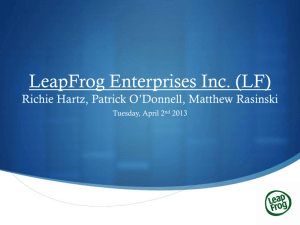
![[Date] - The Leapfrog Group](http://s3.studylib.net/store/data/007452128_1-2ccdaf0edc6c4762b1c242b11ae884dc-300x300.png)
